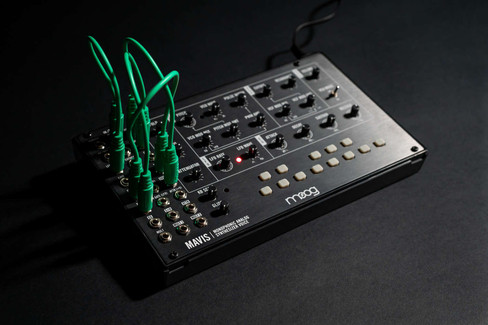Moog Mavis
- Jeremy Spurgeon

- Jul 3, 2022
- 3 min read
Updated: Sep 23, 2022
In an interesting design move, Moog releases its first ever synth to feature a diode wavefolder. Combining traditional subtractive synthesis with additive wavefolding, Moog embarks on a journey into uncharted territory.
Back in 2014, Moog introduced the Werkstatt-01 kit as part of Moogfest. It featured a single oscillator, the famous ladder filter that Moog is known for, a built-in one-octave keyboard, and a unique patchbay that used jumper wires for patch cords. Later, they made the Werkstatt-01 part of their regular line of synths and upgraded the patchbay with an additional circuit board that contained 1/8" jacks. It has been a popular item and for a while, second-hand prices climbed beyond the original retail price.
It would seem that the Werkstatt-01 has been reborn as the Mavis, or at least the same business model was used, and why not? For anyone who is interested in a DIY kit that isn't too difficult to assemble and wants to add the legendary Moog sound to their arsenal, the Werkstatt-01 and now the Mavis are a great way to do so. In fact, as the prices for the Werkstatt-01 continue to fall, why not pick up one of each?
This time around Moog has improved many of the features that were lacking on the Werkstatt-01. They improved the patchbay with more options and a dedicated section built into the front panel. While the jumper wire format of the Werkstatt-01 is convenient if you have other devices that use them, like the Korg Modular, the CV Expander is awkward, and the orientation of the jacks make it difficult to use in tight spaces. They have also improved the keyboard, with larger, rubberized buttons. Perhaps the biggest improvement is that it can be mounted in a Eurorack system, like the Mother-32.
The Mavis is a monophonic analog synth with a voltage-controlled oscillator (VCO) with mixable saw and square waves, pulse width modulation (PWM), and modulation source mixing. It also includes Moog's famous -24 dB, low pass ladder filter, an audio rate low-frequency oscillator (LFO) with mixable triangle and square waves, and a 4-stage envelope generator. The Mavis uses crossfaders for its modulation routing instead of switched like the Werkstatt-01, which allows you to blend between the LFO and envelope for more interesting modulation options. And for the first time in Moog's history, a wavefolding circuit is included, allowing additive synthesis and traditional subtractive synthesis in the same instrument. The modular patchbay provides many useful connections for integrating the Mavis into a modular system, including attenuator, offsets, mults, and a flexible DC-coupled mixer. There is even a patchable sample and hold (S+H) circuit that generates a random CV pattern that can be used to modulate parameters, or as a random note generator. The one-octave keyboard can be used to control other modular devices and includes a glide control and a unique scale feature that allows you to dial in experimental musical intervals that go beyond standard scales.
Overall, I think the Mavis is a fantastic addition to the Moog line-up. It is a step up from the Werkstatt-01, with the improved patchbay and standardized design. It offers new and creative options that allow for better integration into your established workflow, and it is a powerful little synth. If you have always wanted to get your hands on the legendary Moog sound and want an inexpensive synth that is highly expandable, then the Mavis is just what you have been waiting for.
For more information visit:


















Comments